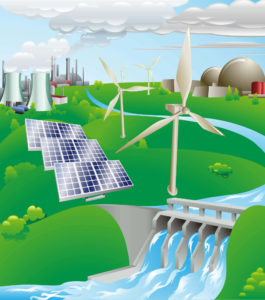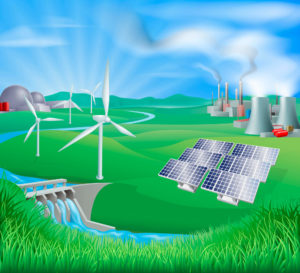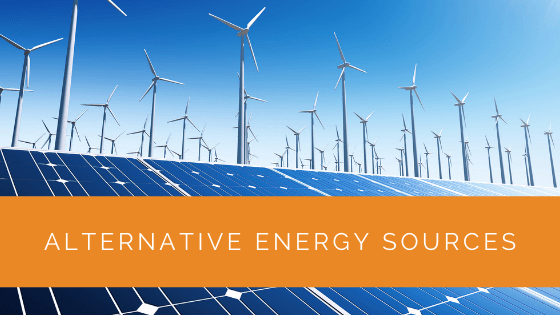As fossil fuels are moving towards an extinction phase, an array of alternative energy-producing means are being adopted. Wind, biomass, tidal, and geothermal energy are commonly used renewable energy sources.
This article will look at these clean energy sources in depth. You will be able to identify some of their positives along with low energy bills and create environmental awareness.
Contents
Key Takeaways
- Renewable energy sources such as wind, geothermal, biomass, and solar are gaining prominence as alternatives to fossil fuels due to their sustainability and low environmental impact.
- Each renewable energy source has unique advantages and challenges, with wind energy being popular but potentially impacting wildlife, geothermal energy being underutilized in some regions like the UK, and solar power offering significant cost savings but degrading over time and being weather-dependent.
- Hydroelectric energy, tidal energy, natural gas, hydrogen gas, and wave energy are additional renewable energy options with varying degrees of development and environmental considerations.
What Are Renewable Energy Sources?
Renewable energy sources refer to sustainable energy. These alternative energy technologies, like the water, sun, or wind, cannot run out and are typically endless. They are considered alternative energy sources because of their limitless use instead of traditional fossil fuels such as coal.
These sources create energy that doesn’t contribute to global warming, has a very low carbon footprint, and helps generate electricity at nominal prices. Some of the most common renewable energy sources have been discussed below! Read on.
Wind Energy
Probably, one of the most popular alternative energy is none other than wind energy. Over the years, it has gained even more precedence owing to the high benefits involved. Wind energy produces no greenhouse gas emissions and has absolutely zero waste.
Wind farms are gaining immense popularity in the UK, and you will surely be able to spot one on your way to the countryside. They are making a huge contribution to the national grid!
Harnessing electricity from wind power is not a simple task, though. Several turbines have to be put in place to drive generators. These generators feed electricity to the National grid afterwards.
You may be able to find off-grid or domestic generation systems as well. The only catch here is that not all properties will not work well with domestic wind turbines.
Most cities in the country have a wind energy setup and some investment in alternative energy. Additionally, certain challenges are associated with this renewable energy source, such as windmills blocking views and can even be dangerous to some wildlife and flora.

Geothermal Energy
Geothermal energy is renewable energy wherein the natural heat below the earth’s surface is harnessed. This alternative energy is utilized to heat homes and generate electricity rather than fossil fuels.
Even though geothermal power harnesses power just below our feet, this alternative energy is still to achieve focus in the UK. Other countries like Iceland use geothermal energy way more readily.
Biomass Energy
There are several forms when we talk about biomass energy. We have known the business of burning wood for a long time now! But just imagine the energy we can produce by burning waste from landfills and alcohol products!
Well, this is what is referred to as biomass energy. The heat generated in wood burning is almost equal to that of a central heating system.
The costs incurred while using geothermal power are pretty low. Moreover, the carbon footprint of these types of renewable energy is way less than that of fossil fuels.
However, some problems are associated with using this renewable power, more so if it is installed in your house.
The biggest negative in their energy production is the maintenance required. You will also have to request permission from some local authority to install them to generate energy in your home!
Solar Power
Solar power is one of the largest renewable energy sources ever! Solar cell technology has advanced over the years and is used on a large scale to produce electricity.
Many countries have even started various initiatives to elevate the growth of solar energy as green energy! The Feed-in tariff system is one example of the solar power scheme concerning solar panels’ energy consumption.
The best of these energy sources is that it is renewable, and the reduced energy bills quickly cover the cost involved in the installation compared to traditional energy sources.
The con of solar power is that it is pretty usual for them to get degraded over a longer period. Additionally, this alternative energy source is ineffective during unusual weather conditions.
Nuclear Energy
Nuclear energy is a pretty abundant form of energy source. It has many advantages when we look at the emissions and the efficiency involved during their energy consumption.
Thirteen countries have trusted nuclear energy sources to generate electricity! Currently, there are 450 power plants in proper operation around the globe.
The primary risk involved in nuclear energy is that if something were to go wrong in the plant, the world awaits a catastrophe, just like the time in Fukushima or Chornobyl.
Hydroelectric energy
Hydroelectric energy is a renewable energy that dates longer than you would have thought! It was active even before the use of fossil fuels.
Post the popularity of coal and petroleum, Hydroelectric energy quickly lost its charm amongst the crowds. Even with these situations, it is a big hit in many countries and industries.
Hydroelectric energy has a series of benefits. It is a very clean energy source so you can say goodbye to pollution and all the issues associated with global warming.
This renewable energy also has many secondary benefits, making it pretty advantageous. The dams are responsible for creating hydroelectric power, helping in controlling floods, and initiating irrigation techniques.

Tidal Energy
Tidal energy is another renewable energy that is based on hydroenergy. It utilizes the twice-daily currents to drive the turbine generators.
Unlike other hydroenergy sources, tidal flow is not very constant, so it can get highly unpredictable. They might even need to be compensated on days when the tide current is pretty low.
Tidal energy is also pretty similar to wind turbines in various cases. Even though it is a new technology, this renewable energy’s expansion and impact are huge.
Currently, 20% of the energy demands of the United Kingdom can be met by tidal energy itself.
Natural Gas
Natural gas has also been a popular form of renewable energy for many years! With the progression of compression methods, natural gas is becoming a viable energy source.
Natural gas is particularly used in vehicles to reduce carbon emissions.
The global demand for natural gas is also increasing rapidly! On the downside, the chances of natural gas contamination are way higher than other alternative energy sources!
Hydrogen Gas
Opposite to popular opinion, Hydrogen gas is a very clean-burning fuel. After producing this energy, the hydrogen gas gives off only warm air and water vapour during their usage.
One of the main issues with this type of renewable energy is that it is largely derived from the active usage of fossil fuels and natural gas. This could mean that the benefits it provides counteract how it extracts them.
Moreover, electrolysis, the process behind splitting H2O into oxygen and hydrogen, reduces the chance of an issue.
But, still hydrogen gas is less popular than the other energy sources mentioned in the article. Research continues to alter it into a more cost-effective and efficient form of energy.
Wave Energy
Wave energy or hydro energy is one of the most commercially developed forms of renewable energy.
Building a barrier, reservoir, or dam can help create a more controlled flow of water, which will be responsible for driving the turbine and generating electricity.
Wave energy is way more reliable than other forms of renewable energy like wind power or solar power.
This factor also helps in storing electricity when demand is pretty high. Like wind energy, hydro energy can be considered a pretty commercial energy source. This also varies according to the type and the other energy sources used.
You will have to check the type of property for it to be used as a domestic or off-grid generation.
Case Study: Solar Panel Installation in a Residential Community
Background
At Solar Panels Network, we are dedicated to promoting the use of solar energy as a key component of sustainable living. This case study focuses on a residential community project where we installed solar panels to provide clean, renewable energy, significantly reducing reliance on traditional energy sources.
Project Overview
The project’s objective was to install solar panels across multiple homes in a residential community, aiming to reduce electricity costs and promote environmental sustainability. The community, located in a region with ample sunlight, presented an ideal setting for harnessing solar energy.
Implementation
- Site Assessment and Planning: We began with a detailed site assessment to evaluate each home’s roof orientation, shading, and structural integrity. This assessment was crucial to determine the optimal placement of solar panels for maximum efficiency.
- Solar Panel Installation:
- Selection of Solar Panels: We selected high-efficiency photovoltaic panels known for their durability and performance, ensuring long-term energy production.
- Installation Process: Our team of experienced installers carefully positioned the panels on rooftops, aligning them to capture the most sunlight throughout the day. We also installed inverters to convert the generated DC power into usable AC power for the homes.
- Integration with Existing Systems: The solar systems were seamlessly integrated with the existing electrical grids of the homes. Additionally, we provided battery storage solutions for several households, allowing them to store excess energy for use during non-sunny periods.
- Community Engagement and Education: We organised workshops and provided informational materials to educate residents on the benefits of solar energy, maintenance tips, and how to monitor their energy production and consumption using the installed systems.
Results
- Energy Production: The installed solar panels collectively generated a substantial amount of electricity, meeting an average of 60% of the community’s total energy needs. This contribution significantly reduced the community’s dependence on the national grid.
- Cost Savings: Homeowners experienced a noticeable decrease in their monthly electricity bills, with some households reporting savings of up to 50%. The financial benefits were immediate, with the expected payback period for the installation costs estimated at five to seven years.
- Environmental Impact: The solar installations helped the community reduce its carbon footprint, preventing the release of approximately 150 tonnes of CO2 annually. This initiative supported the community’s commitment to sustainable living and environmental stewardship.
Summary
The solar panel installation project in this residential community was a resounding success, demonstrating the practical and financial benefits of transitioning to renewable energy. By leveraging the abundant solar resources available, the project not only provided substantial cost savings for residents but also made a significant positive impact on the environment. This case study highlights the effectiveness of solar energy in reducing dependency on traditional power sources and underscores the importance of community-wide adoption of renewable energy solutions. As Solar Panels Network continues to champion sustainable energy practices, projects like this serve as a blueprint for other communities looking to embrace clean energy.
Expert Insights From Our Solar Panel Installers About Alternative Energy Sources
Each alternative energy source has unique advantages that make it suitable for different environments and needs. For instance, wind energy is excellent in regions with consistent wind patterns, while solar power excels in sunny areas.
Renewable Energy Engineer
Hydroelectric and tidal energy are fantastic for coastal and riverine areas, providing reliable and continuous energy supply, although they require significant upfront infrastructure investments.
Senior Hydropower Specialist
One of the key challenges with alternative energy sources like biomass and geothermal energy is ensuring that the methods used to harness them are environmentally sustainable and economically viable.
Environmental Impact Consultant
Discover the Power of Solar with Solar Panels Network
Are you navigating the world of solar installations? Look no further than Solar Panels Network, the UK’s trusted partner in harnessing the sun’s potential. Our dedication goes beyond just installations; we’re on a mission to transform how homeowners and businesses across the UK perceive and utilise energy. By choosing us, you’re reducing your carbon footprint and making a smart financial move that promises savings for years ahead. Contact us today and embark on your solar journey.
Wrapping Up
This article gives all the information you need on alternative or renewable energy.
All these types of energies have pros and cons that depend wholly on your requirements and global demand.
Do your bit to bring in the change to save our planet.
About the Author
Solar Panels Network stands at the forefront of solar energy solutions, driven by a team of seasoned solar engineers and energy consultants. With over decades of experience in delivering high-quality solar installations and maintenance, we are committed to promoting sustainable energy through customer-centric, tailored solutions. Our articles reflect this commitment, crafted collaboratively by experts to provide accurate, up-to-date insights into solar technology, ensuring our readers are well-informed and empowered in their solar energy decisions.

